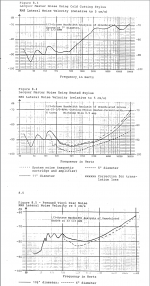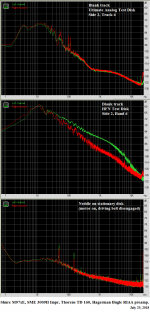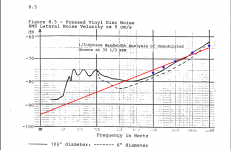See first attachment from the same Ortofon paper, surface noise not exactly flat.What I can offer you so far is the following.
Starting with the assumption that noise from the LP is flat, after Riaa compensation it will have to follow the Riaa curve.
Then some recordings of mine. Even for blank groove noise spectrum, we are at the mercy of the various Test LPs.
I can’t find my flat recordings now, I have to make some new.
George
Attachments
In the Ortofon paper chart for vinyl pressing George posted above, the shape of the noise versus f curve fits fairly well with scaling by rpm. There is then also the expected level difference in playback level between inner and outer radius tracks, which roughly scales with rpm even for surface noise. I suppose this suggests groove surface roughness/tribology is what it is when the record was made: playback reproduces this and is not the limiting factor?
LD
LD
Last edited:
George,
Thank you for making this info available.
Fig 8.5 concerns the pressed vinyl version, so I concentrated on that one.
Surface noise is shown in 1/3 oct bandwidth, resulting in an upgoing spectrum with 10dB/oct.
I have drawn in red this 10dB/oct line, showing that from a few hundred Herz up to 20kHz, surface noise is flat within a few dB.
I have painted in blue dots the results of my recent measurements, the same data that was also used in the table.
Results conform very well to each other as can be seen.
Hans
P.S. My assumption was that no Riaa de-emphasis was used at play back.
Thank you for making this info available.
Fig 8.5 concerns the pressed vinyl version, so I concentrated on that one.
Surface noise is shown in 1/3 oct bandwidth, resulting in an upgoing spectrum with 10dB/oct.
I have drawn in red this 10dB/oct line, showing that from a few hundred Herz up to 20kHz, surface noise is flat within a few dB.
I have painted in blue dots the results of my recent measurements, the same data that was also used in the table.
Results conform very well to each other as can be seen.
Hans
P.S. My assumption was that no Riaa de-emphasis was used at play back.
Attachments
Last edited:
I know I had a homework task to try and get some data on cartridge deviations from spec and I have somewhat stalled as don't have enough measurements without setting up something myself for adding more.
But with what I have, if you ignore the some late 70s oddities and concentrate on things in production or just out of production then mV/H output does cluster around the 6-10.5 range. I don't have enough data to see how L and R track on cartridges yet, but working on it.
Looking at real numbers vs manufacturer specs for L I'm struggling. I have a set of numbers all done on the same meter for a range of AT cartridges and the headlines so far are
1. The channels are generally within 2% of each other, which is good
2. Across the range they are either a bit low (around 5%) or a bit high (around 5%) with some a lot worse.
Right now I am not sure I trust the LCR meter that was being used between sessions other than for the channel balance numbers.
I'll keep digging as it's important to me to get some better measurements.
@George: If you are able to get a good measurement of L and R for those Ortofons you have I would be most appreciative.
But with what I have, if you ignore the some late 70s oddities and concentrate on things in production or just out of production then mV/H output does cluster around the 6-10.5 range. I don't have enough data to see how L and R track on cartridges yet, but working on it.
Looking at real numbers vs manufacturer specs for L I'm struggling. I have a set of numbers all done on the same meter for a range of AT cartridges and the headlines so far are
1. The channels are generally within 2% of each other, which is good
2. Across the range they are either a bit low (around 5%) or a bit high (around 5%) with some a lot worse.
Right now I am not sure I trust the LCR meter that was being used between sessions other than for the channel balance numbers.
I'll keep digging as it's important to me to get some better measurements.
@George: If you are able to get a good measurement of L and R for those Ortofons you have I would be most appreciative.
I can’t find my flat recordings now, I have to make some new.
George
The 1/3 octave plots will slope up with white noise and the FFT plots will be flat. I have to check but I remember my silent groove tracks following the RIAA curve. Easy to check again.
The Ortofon cutter chart noise measurement more or less confirms what we know - that surface noise spectrum is dominated by roughly a 1/f flicker law below a few hundred Hz, and is otherwise dominated by a white-ish noise floor at some cross-over point.
All of which is statistically random, and subject to crest factors etc etc.
If RIAA playback is used to play back a silent groove, this will all be subject to RIAA deemphasis curve which mostly aggravates the 1/f noise content and suppresses the hf content.
There shouldn't be cutter-induced deviations in the f domain, because there should not be cutter modulation in a silent groove. Anything that is left over and permanent in the groove prob either arises from the lathe table, or cutter screw. But seems to be dominated by 1/f noise at lf and white noise at mid/high f whatever.
I suppose if one is selling cutter heads, that is what the literature would say...…………………...
LD
All of which is statistically random, and subject to crest factors etc etc.
If RIAA playback is used to play back a silent groove, this will all be subject to RIAA deemphasis curve which mostly aggravates the 1/f noise content and suppresses the hf content.
There shouldn't be cutter-induced deviations in the f domain, because there should not be cutter modulation in a silent groove. Anything that is left over and permanent in the groove prob either arises from the lathe table, or cutter screw. But seems to be dominated by 1/f noise at lf and white noise at mid/high f whatever.
I suppose if one is selling cutter heads, that is what the literature would say...…………………...
LD
Last edited:
A few years ago a guy named David Laloum fairly meticulously measured MM/MI cartridge inductance/resistance and compared to spec, including L/R balance.I know I had a homework task to try and get some data on cartridge deviations from spec and I have somewhat stalled as don't have enough measurements without setting up something myself for adding more.
But with what I have, if you ignore the some late 70s oddities and concentrate on things in production or just out of production then mV/H output does cluster around the 6-10.5 range. I don't have enough data to see how L and R track on cartridges yet, but working on it.
Looking at real numbers vs manufacturer specs for L I'm struggling. I have a set of numbers all done on the same meter for a range of AT cartridges and the headlines so far are
1. The channels are generally within 2% of each other, which is good
2. Across the range they are either a bit low (around 5%) or a bit high (around 5%) with some a lot worse.
Right now I am not sure I trust the LCR meter that was being used between sessions other than for the channel balance numbers.
I'll keep digging as it's important to me to get some better measurements.
@George: If you are able to get a good measurement of L and R for those Ortofons you have I would be most appreciative.
It looks as though the measurements are still up on his site, ZevAudio. I was able to pull down a few as a guest before the hosting software booted me off requiring registration. So I registered but didn't get a ticket. Perhaps someone already has access, or might have better luck ?
LD
well that is bothersome. For the one cartridge I have 2 sets of measurements for (AT-440) Zev is low on L and the other measurements are high. So either we can't entirely trust the measurement methods or we have a +6/-3% tolerance. I need to go mull what this might actually mean....
It is a hard task, but when you have been making effectively the same generator for 40 years one might think that they had the process down to a fine art. If of course they were bothered!
I suspect their might be some selection going on so the more expensive models get the better matching. Certainly AT/Signet did that in the 70s.
Anyway back on the accuracy deviation from this. Hans came up with a very different answer to me and still trying to work out what I have done wrong. I looked at it from a reference point of 1kHz as all RIAA accuracy is normally done and from that starting point to my eyes everything is fine from 500Hz upwards as the pole and zero are all handled. The problem comes with the correction for initial roll off from the trans loading. So for example the correction starts at 318Hz but the actual cart rolloff doesn't start until 350Hz. To me this area is the only error and will be of the order of a dB of so (need to calculate this as lost my notes on that). Now I have biquads to burn on miniDSP so a simple shelf to correct this would work for me (and we are well into the modal range in my room).
What have I missed?
I suspect their might be some selection going on so the more expensive models get the better matching. Certainly AT/Signet did that in the 70s.
Anyway back on the accuracy deviation from this. Hans came up with a very different answer to me and still trying to work out what I have done wrong. I looked at it from a reference point of 1kHz as all RIAA accuracy is normally done and from that starting point to my eyes everything is fine from 500Hz upwards as the pole and zero are all handled. The problem comes with the correction for initial roll off from the trans loading. So for example the correction starts at 318Hz but the actual cart rolloff doesn't start until 350Hz. To me this area is the only error and will be of the order of a dB of so (need to calculate this as lost my notes on that). Now I have biquads to burn on miniDSP so a simple shelf to correct this would work for me (and we are well into the modal range in my room).
What have I missed?
Today I have played the Pink Noise track on the Adjust+ record at 33 1/3, 45 and 60.75rpm.
Two things were very different to the CH Precision record:
1) Each step upwards in speed resulted in shifting the spectrum by 1.3dB upwards, whereas with the CH Precision record all 3 spectra where on top of each other.
But this time it finally proves after all that a speed change by 1.35x results in 2.6dB level increase.
Why this did not happen on the CH record remains a mystery.
2) Spectra where shifting horizontally a factor 1.35 each time, but did not show the strange behaviour from the CH Precision record where at 45rpm FR was within +/-0.5dB up to 30kHz, but at 33 1/3rpm 20kHz was 3dB down.
This all shows that the world of recorded Pink noise has it's own laws and dynamics.
Depending on factors not at all clear to me, every record behaves differently.
Only the CH record is within +/-0.5dB from 2kHz to 30kHz when played at 45rpm and should at this speed be an ideal medium to further investigate MM Carts.
Hans
Two things were very different to the CH Precision record:
1) Each step upwards in speed resulted in shifting the spectrum by 1.3dB upwards, whereas with the CH Precision record all 3 spectra where on top of each other.
But this time it finally proves after all that a speed change by 1.35x results in 2.6dB level increase.
Why this did not happen on the CH record remains a mystery.
2) Spectra where shifting horizontally a factor 1.35 each time, but did not show the strange behaviour from the CH Precision record where at 45rpm FR was within +/-0.5dB up to 30kHz, but at 33 1/3rpm 20kHz was 3dB down.
This all shows that the world of recorded Pink noise has it's own laws and dynamics.
Depending on factors not at all clear to me, every record behaves differently.
Only the CH record is within +/-0.5dB from 2kHz to 30kHz when played at 45rpm and should at this speed be an ideal medium to further investigate MM Carts.
Hans
Exactly. Unfortunately, real programme material more closely resembles pink noise than f sweeps.....This all shows that the world of recorded Pink noise has it's own laws and dynamics.
Exactly.Depending on factors not at all clear to me, every record behaves differently.
Perhaps, but maybe it is tuned or a happy coincidence to give that result, and who is to say what is a real and true response? This is tricky. I thought to use a calibrated mechanical jig to move the stylus as a reference - but how to calibrate any such jig is the problem...….? Interferometry perhaps.Only the CH record is within +/-0.5dB from 2kHz to 30kHz when played at 45rpm and should at this speed be an ideal medium to further investigate MM Carts.
LD
but how to calibrate any such jig is the problem...….? Interferometry perhaps.
LD
A high quality piezo-accelerometer should not need further calibration the trick would be to find one that does 20kHz. Another thing, I have not read the B&K article in detail but how do you excite the cartridge in other than a purely vertical direction?
A high quality piezo-accelerometer should not need further calibration the trick would be to find one that does 20kHz. Another thing, I have not read the B&K article in detail but how do you excite the cartridge in other than a purely vertical direction?
The B&K accelerometer is in a little stand on some foam going horizontally. I think you can tilt the stand but I'm not sure that would get to 45 degrees and still hold the cartridge. As I remember there were several of those exact accelerometers on eBay a short while ago. Still some: Bruel & Kjaer 8307 Piezoelectric charge shock accelerometer /DS 0041 | eBay
IIRC the B&K article used a piezo accelerometer as a motor, but it required extensive calibration that personally I remain unconvinced about, and a thumping in-band resonance.
I had considered a mechanical cam based vibrating platform, or voice coil actuated platform. But still calibration and proof of no self-resonance remains tricky.
Still, it would be fun to have a go...……..
LD
I had considered a mechanical cam based vibrating platform, or voice coil actuated platform. But still calibration and proof of no self-resonance remains tricky.
Still, it would be fun to have a go...……..
LD
IIRC the B&K article used a piezo accelerometer as a motor, but it required extensive calibration that personally I remain unconvinced about, and a thumping in-band resonance.
I was thinking of using it as a sensor with something else as a driver but still there is the resonance issue. There are 3 axis MEMS accelerometers but I'm not sure any are over a few kHz.
- Status
- This old topic is closed. If you want to reopen this topic, contact a moderator using the "Report Post" button.
- Home
- Source & Line
- Analogue Source
- Cartridge dynamic behaviour


